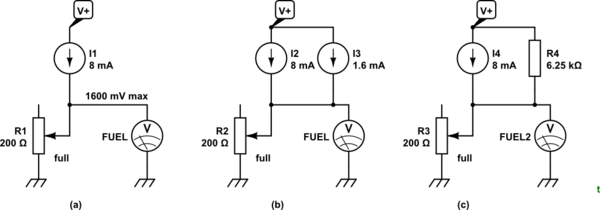I have a fuel sender in my kit car that goes from 20R to earth (full) to 200R (empty). Unfortunately the gauge (constant current source, measuring resistance to earth?) expects empty to be 240 ohms, so displays '1/4 full' when empty. What is the simplest analogue way to make 20-200R look like 20-240R?
(40R in series gives a full tank showing '3/4 full' on the dial: Still not ideal!).
So, a great suggestion from Transistor (below). I think I'll change R4 in his/her Figure 1 to a constant current source since car volts can vary quite a lot!
I believe the value for R3 (above) will be fairly independent of the transistor specs?
Update: Yes, this works nicely, gauge now goes from full to zero. I put R3 on a little trimmer - 720R for 1.6mA. Many thanks transistor!




